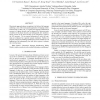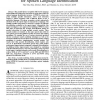5 search results - page 1 / 1 » Using cross-decoder phone coocurrences in phonotactic langua... |
ICASSP
2010
IEEE
13 years 5 months ago
2010
IEEE
Phonotactic language recognizers are based on the ability of phone decoders to produce phone sequences containing acoustic, phonetic and phonological information, which is partial...
ICASSP
2011
IEEE
12 years 9 months ago
2011
IEEE
Due to computational bounds, most SVM-based phonotactic language recognition systems consider only low-order n-grams (up to n = 3), thus limiting the potential performance of this...
NAACL
2003
13 years 6 months ago
2003
This paper describes an application of active learning methods to the classification of phone strings recognized using unsupervised phonotactic models. The only training data req...
ICASSP
2010
IEEE
13 years 5 months ago
2010
IEEE
Phonotactic approach, phone recognition to be followed by language modeling, is one of the most popular approaches to language identification (LID). In this work, we explore how ...
TASLP
2008
13 years 5 months ago
2008
The parallel phone recognition followed by language model (PPRLM) architecture represents one of the state-of-the-art spoken language identification systems. A PPRLM system compris...


